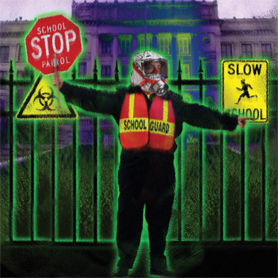Upon review of the Environmental Impact analysis (EIA) Phase 1 and 2 for the construction of a high-school proposed by the School Construction Authority of New York City, we find a number of major environmental health concerns. The major problems and conclusions that have recently been brought to light are to the result of inadequate evaluations conducted by scientists that do not have appropriate backgrounds in engineering and general geology. To adequately assess concerns pertaining to chemical toxins and potential human exposure, risks associated with such compounds need to be evaluated by scientists that have backgrounds in toxicology, along with those having appropriate experience in earth & geological sciences. There are critical pedagogical differences between the SCA Health and Hygiene experts that came forward during the discussion at the JPCA Town Meeting in April. We propose to have a meeting at Pace University with a panel of appropriate experts that can properly debate these issues.
I have concluded that the chemical compounds that are proposed to be left in the soil with the current environmental controls will cause a serious health concern, including risk of cancer. Chemicals such as 1, 2-Benzo-anthracene, and Benzo[a]pyrene are known chemical carcinogens that bind with DNA, thereby causing mutations by disrupting the double-helical DNA structure. This can then disrupt the normal process of copying DNA that have been linked to cancer after exposure. This mechanism of action is similar to that of aflatoxin, which binds to the N7 position of guanine. These are major mutational hotspots in human respiratory cancers. Thus, targeted adduct formation, rather than phenotypic selection, appears to shape the P53 mutational spectrum in cancer. These results provide a direct etiological link between a defined chemical carcinogen and human cancer.
Summary:
It is imperative that the points listed below are addressed to ensure that the building development will not create health issues for future students, faculty, and staff of the school. These simple but necessary measures will assist in the creation of a safe environment.
I. Improved Vapor Monitoring System
The current plan currently involves the installation of a sub-slab depressurization system. This system, included supposedly as a purely precautionary measure for the removal of gases, allows for the capture and elimination of VOCs (Volatile Organic Carbon). However, at this point in planning, the system lacks necessary vapor indicators. We require the installation of an automated monitoring system, equipped with a light indication when hazardous gases are present. This system should be checked periodically, both for presence of gases and for simple maintenance, for the life of the school in order to provide continuous reports on the environmental state of the building.
II. Soil Quality
Under the Resource Conservation and Recovery Act (RCRA) regulations, many of the chemical toxins found at this site are hazardous wastes. Thus, the remediation of SVOCs, VOCs, and heavy metals found within the contaminated soil at this location need to fit a specific site clean up standard due to the proposed building of a school that will sit on the top of this soil. Some of the data tables provided to the public do not differ from any other Brownfield soil remediation projects throughout the City of NY. One such example: the levels of mercury are between 3-8 times higher than Eastern Background levels found in DEC TAGM#4046 criteria soil objective targets. S-VOCs are a staggering 1000-3000 times higher from the data provided to me from soil tests that were conducted at the site location. We request that the Juniper Park Civic Association be involved in a more in-depth chemical sampling and the samples be sent to York Analytical Labs in CT and analyzed by Dr. J.M. Cervino.
It should be duly noted that there is no floating petroleum product containing PCBs found at this site from the transects provided to Councilman Tony Avella and myself. The RCRA phenomenon is correlated with the degree of industrialization and intensity of chemical usage along with improper disposal of chemicals on and surrounding this particular industrial location that will be home to a high school.
Therefore, I, as a scientist, recommend and feel it necessary to include the Determination Of Soil Cleanup Objectives and Cleanup Levels to meet the (TAGM-#4046) clean-up objective program http://www.dec.ny.gov/
regulations /2612.html and DEC Sub-part 375. We demand the importation of soil that meets the criteria of TAGM 4046 and Sub-part 375 soil than what is currently being proposed. All contaminated material must be removed and taken away from this site. We insist on the highest quality available soil to be brought into the construction zone after excavation of contaminated soil, rather than background levels for the New York City tri-state area. Soil chemical levels that are within the law are not necessarily the best available and do not necessarily ensure that health issues will not arise from their presence.
This recommendation using the 4046 cleanup objective is based on the criterion that produces the most stringent cleanup level using criteria a, b, and c for organic chemicals, and criteria a, b, and d for heavy metals. If criteria a and/or b are below criterion d for a contaminant, (see DEC Website http://www.dec.ny.gov /regulations /2612.html) its background value should be used as the cleanup objective.
**However, cleanup objectives developed using this approach must be, at a minimum, above the method detection limit (MDL) and it is preferable to have the soil cleanup objectives above the Contract Required Quantitation Limit (CRQL) as defined by NYSDEC. If the cleanup objective of a compound is “non-detectable”, it should mean that it is not detected at the MDL. Efforts should be made to obtain the best MDL detection possible when selecting a laboratory and analytical protocol.
Disposal Methodology
Ship to Treatment, Storage, or Disposal Facility: If the soil from this location is a hazardous waste, it can be shipped to a treatment, storage, or disposal facility. In accordance with RCRA land disposal restrictions, soil, which is a characteristic hazardous waste due to contamination, must be placed in a hazardous waste landfill. We demand to see the manifests from the appropriate solid waste landfill facilities and request the geographic location as to where this material is going to be deposited.
III. Receiving Party
A party should be designated for the receipt of periodic reports on the status of the ventilation system. This party will obtain the monitoring summary for review and check on the proper functioning of this system.
Note: See related article on page 16 of the Juniper Berry.




